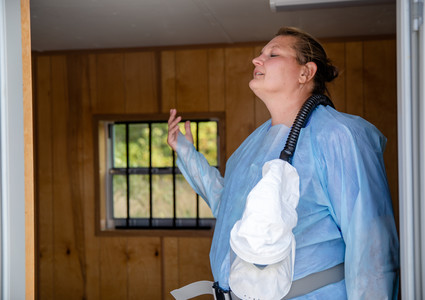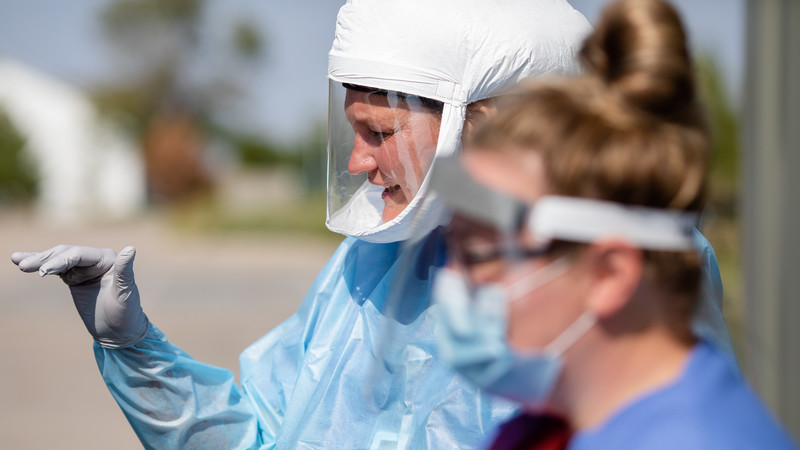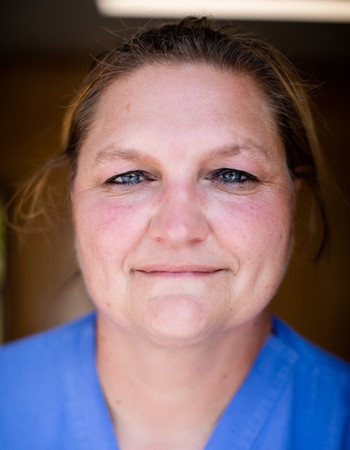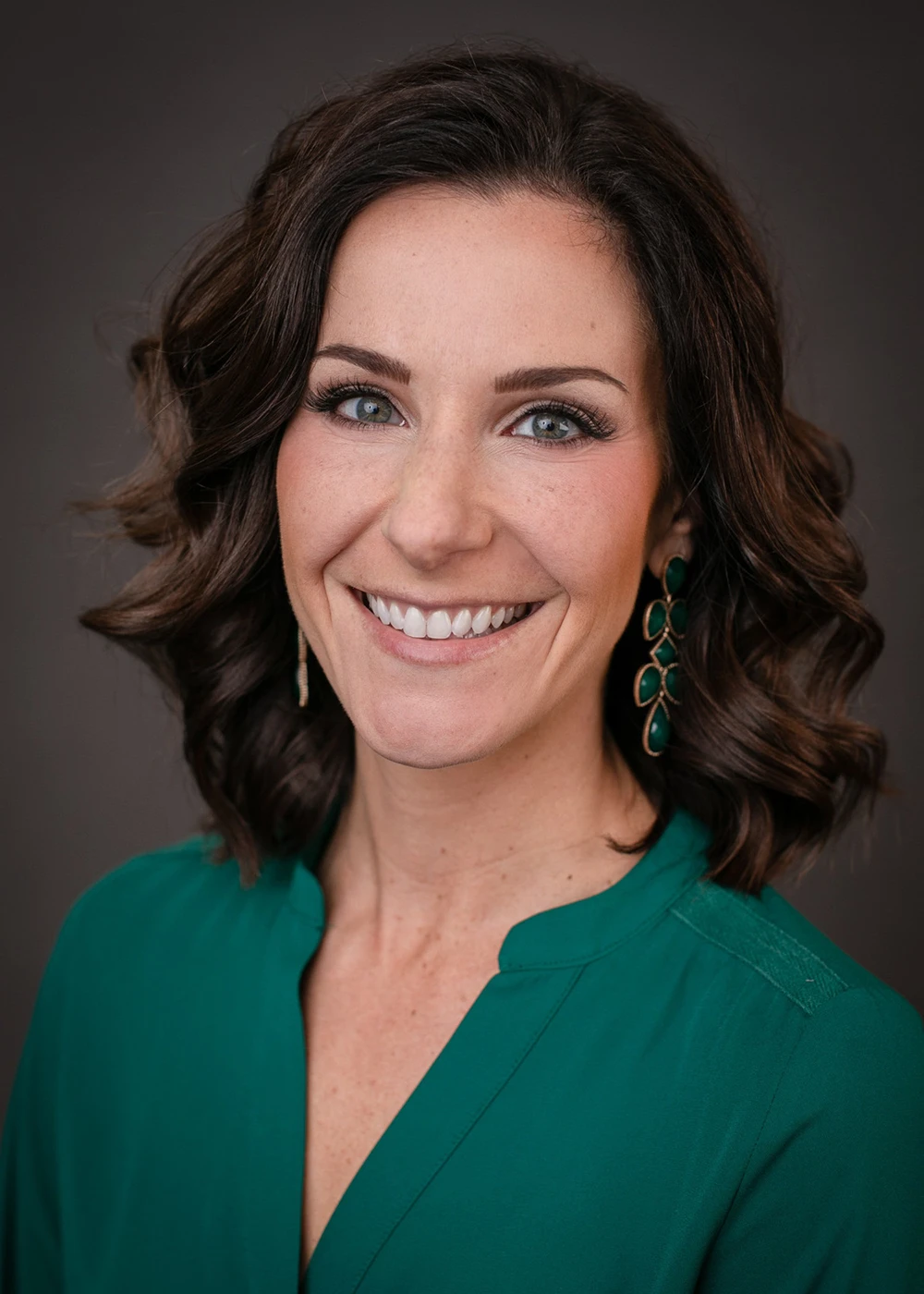




The Meaning of Care Magazine
A True Test of Fortitude: A Day in the Life of a COVID-19 Warrior
Published: Nov. 21, 2020Michelle Vanek, CMA, a certified medical assistant for Methodist Physicians Clinic, didn’t know exactly what she was volunteering for in March, but she knew she had to.
Her supervisor, Joshua Harper, a Methodist Physicians Clinic operations manager, asked his Fremont staff if anyone would be willing to perform COVID-19 testing for the growing number of people in need.
For how long? Could their safety be guaranteed? What would happen if one or several of them contracted the virus?
These were questions Harper didn’t yet have the answers to. Vanek was one of three individuals who stepped forward anyway.
“I thought about the other employees – my coworkers,” Vanek said. “Some were pregnant, some had spouses with underlying conditions. People were scared. And rightfully so.”
“But she’s also the type of person who’d work six days a week if I asked her to,” Harper said. “In fact, she has before. No questions asked. She’s the first to volunteer. That’s just who she is.”
Vanek, a diabetic, wife and mother of three, knew the risk she was taking.
“But it was needed,” she said. “And I knew I needed to do my part.”
What she didn’t know was that she’d still be doing her part over half a year later.
Battling a Virus and the Elements
In March, Methodist Health System set out to contain and help mitigate the spread of COVID-19. Testing was key in those efforts. Methodist Physicians Clinic established drive-thru testing operations in Omaha, Council Bluffs and Fremont. Suddenly, the frontlines became more than a metaphor. They now were visible – with lines of cars and traffic cones mapping out part of a battle in which testers were leading the charge.
“It’s essential for us to know when people are infected,” said Bill Lydiatt, MD, chief medical officer and vice president of medical affairs for Methodist Hospital and Methodist Women's Hospital. “The only way we can do that is by having individuals who are willing to test – willing to go face-to-face with potentially positive individuals and risk exposure themselves.”
Vanek did just that. She braved a virus and the late winter elements simultaneously. When she began testing, it was cold, windy, rainy and snowy.

“But in June and July? It got hot,” she said. “I mean, we would just sweat. Especially on those 100-degree days, it would pool up in our gloves and come pouring out whenever we squeezed our hands.”
Still, she wore a smile. Aside from her gown, gloves and PAPR hood (a protective head covering with an air filtration system), it was the most important thing she donned.
“I vowed early on that I was never going to be the reason someone had a terrible experience here, the reason they told five other people, the reason those five people decided to not get tested because of the experience their friend had.”
Taking the Edge Off With The Meaning of Care
Vanek relies heavily on her positive attitude and uses laughter to help take the edge off a “very uncomfortable” nasopharyngeal swab. According to her, the procedure produces the same burning sensation as a surge of water up the nose.
“She would know,” Harper said. “Because she got tested herself. And she used that to her benefit – the way she started relating to people who’d drive up to get tested.”
“There are so many people that come through just terrified,” Vanek said. “I give them all the same speech: ‘Pretend like you’re driving down the road. Something’s going to go up your nose, but just keep driving.’ They, of course, start laughing, and you can almost see some of that anxiety disappear.”
And that’s important, Vanek said, because staying calm and relaxed can help ensure accurate results.
“When you tense up, it shrinks your nasal passage,” she said. “And essentially, I need to get to the back of your throat.”
While she feels a strong responsibility to do her job correctly, she’s also committed to providing The Meaning of Care to everyone she tests. That was evidenced by the tender approach she used with a 2-year-old in September.
Vanek greeted the young patient with a, “Hi, buddy! Do I have a funny suit on or what?”

After the child’s swab, she spent a few minutes consoling him, demonstrating how adept she’s become at adapting to the needs of all types of patients.
“I don’t want anyone leaving here thinking our only goal was to get them in and out as fast as possible – that we don’t care about them as a person, how they’re feeling and why they’re here,” she said.
“It’s Going to Take a Team Effort”
The long days of testing are something Vanek has gotten used to. Being inches away from someone’s cough or sneeze no longer phases her. She feels safe and remains confident in her ability to avoid contracting the virus. But the return of cooler temperatures feels eerily strange to her.
“I just can’t believe we’re still here,” she said. “I never would have thought I’d still be doing this.”
Even stranger, she said, are the polarizing beliefs and opinions about COVID-19 that still exist.
“I know there are still a lot of disbelievers, but I’ve seen it firsthand,” she said. “It’s not good. There are people I’ve tested who have not made it – people who’ve lost their battle with COVID-19. And that’s extremely hard to swallow.”

While she gets her fair share of thank-you’s from people driving through, she said she most appreciates seeing people masking and taking the proper precautions.
“I’ll keep doing this because it’s what I was supposed to do,” she said. “But it’s going to take a team effort to fight this – not just health care workers.”
“I agree 100%,” Harper said. “Maybe you can’t work the front lines. But you can be responsible, social distance and mask. And if everyone came together, well, maybe that’s one less person that drives through to be tested. Maybe that’s one less hour my staff members – Michelle included – would be working that line. They’re sacrificing a lot.”
And it’s everyone’s responsibility, he said, to sacrifice a little.
Photos and video by Daniel Johnson
More Resources
- Read about the CDC’s recommendations for safe holiday celebrations.
- Learn the difference between a cold, the flu and COVID-19.
- Get similar articles delivered straight to your inbox.


